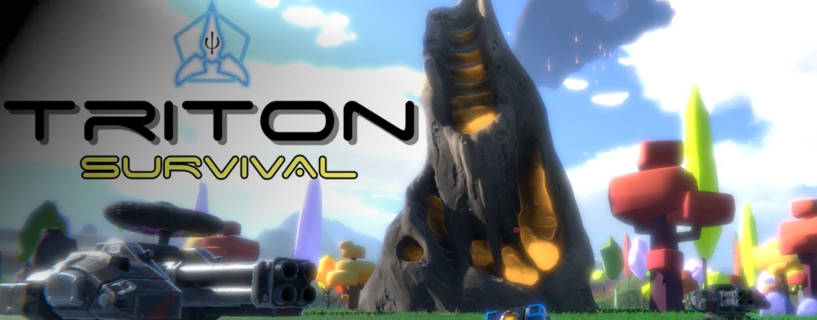Saving Earth, one unit of Uranium at a time … .
Genre: Action, RPG
Developer: DreamsSoftGames
Publisher: DreamsSoftGames
Release Date: 22 Jun, 2019


Introduction
Triton Survival is the latest indie survival-crafting game written in Unity, this time from DreamsSoftGames. I don’t mean to sound jaded, but there seem to have been quite a few of them lately!
In the case of Triton Survival, you play the role of an unnamed soldier in the year 2114, sent from Earth to Triton (one of Neptune’s moons) to guard an alien portal that has been established there, and also to use said portal to travel around Neptune and its moons to destroy other similar portals and remove an invading alien force. (Very little of this is explained in game, but that’s what I took away from the Steam store page, anyway.)
You begin the game on an intriguing representation of Triton. There’s an empty base that looks like it could have been built by humans, a rank of cool-looking vehicles sitting there, idle, and some very colourful flora dotted about the place. Your HUD provides a readout showing the next alien invasion — how, exactly, it knows the time of said invasion is not revealed — so you’d better hurry up and establish some sort of defensive perimeter.
Triton, hey?
So a quick Google search revealed the following known facts about Triton:
- It has an average surface temperature of 34.5 degrees Kelvin.
- It has almost no atmosphere and is within Neptune’s magnetosphere; it’s very unlikely to be able to support life at all.
- It has a surface area of approximately 23018000 square kilometres.
It seems to be a very strange choice of setting for a survival-crafting game involving trees, flowers, pools of yellow water, and exotic flora and fauna, as well as a human protagonist. It’s also rather disappointing that the playable area of Triton in Triton Survival appears to be measureable in single-digit square kilometres (I’m hesitant to say 1 km^2, but I expect it couldn’t be much more than that).
Of course, suspension of disbelief is all part of playing computer games so I’m willing to let the rather unbelievable environment and setting slide. In my opinion, though, a good survival-crafting game needs a vast, interesting, and interactive world, and unfortunately Triton Survival simply doesn’t provide that, or at least not from what I’ve seen so far.
You see, the portal you’re protecting in the game can also be used to travel to Neptune and its other moons, so I can only assume there is (or will be) more to explore upon reaching that stage, but actually getting to the point where you can use the portal for travel is dull and repetitive, and made all the worse by the tiny environment provided by Triton itself.
Resources, Crafting, and Building
For me, the appeal of a survival-crafting game is two-fold: exploring the world and building great stuff while I do it. Now I’ve already described Triton Survival‘s main problem concerning the first point: there’s just not much to explore, and what is there appears to be non-interactive. But how does it rate regarding the second?
Well, a typical survival-crafting game lets the player create basic items and equipment, as well as crafting stations to create higher-tier items and equipment (crafting); and building panels, furniture, and the like (base building); sometimes as well as some sort of static or mobile base defences. Triton Survival is not really any different in this regard. Though the interface is rather clunky, a bit of experimentation and play reveals that it offers most of the usual functionality for the genre: multiple raw resources to harvest/mine, crafting stations to reach second- and third-tier resources, and some basic base building and defences. But there’s not much of any of these categories, or at least not yet.
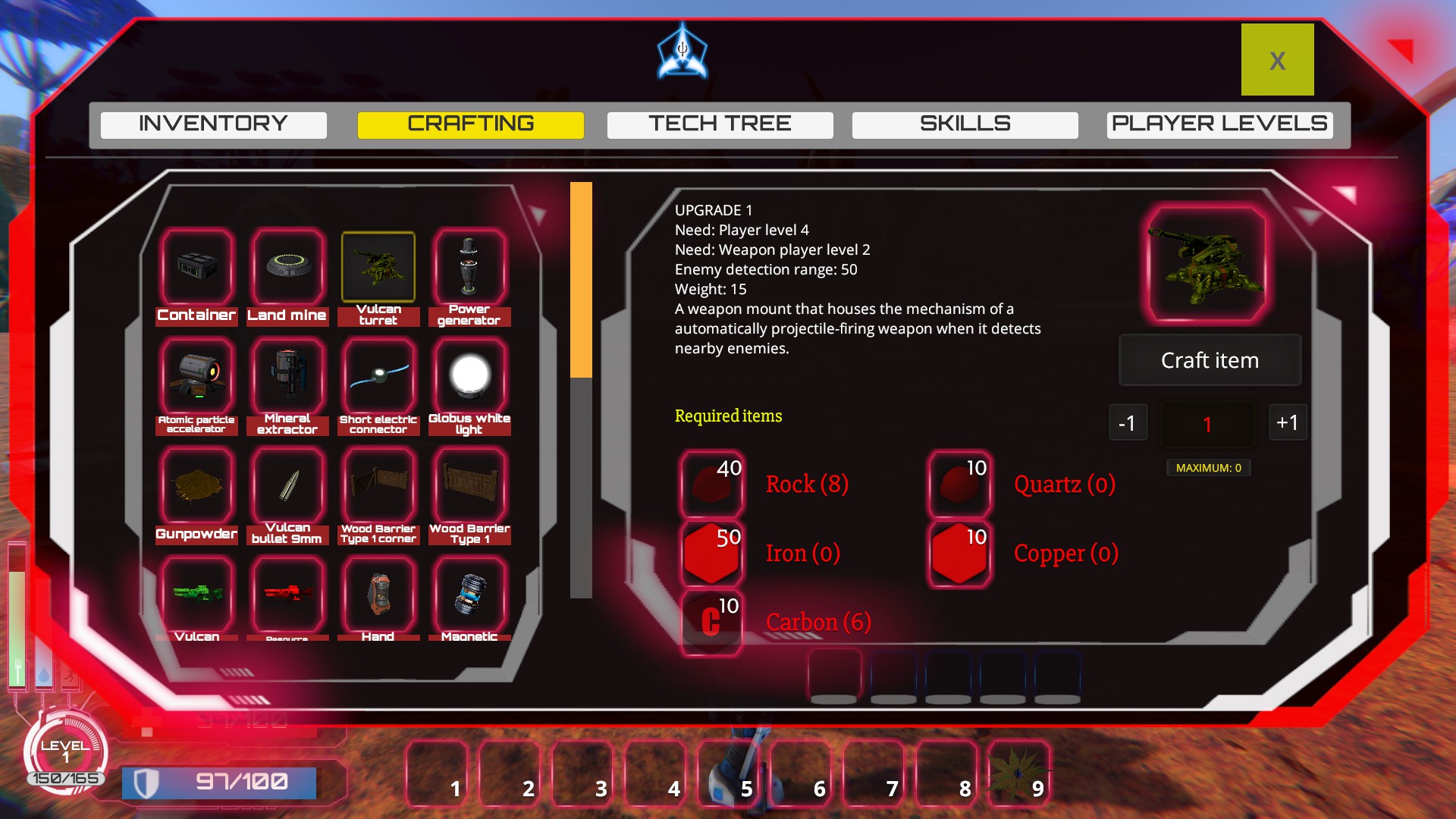
The protagonist is equipped with a sort of powered suit that makes you able to harvest raw resources by running up to one of the conveniently shaped nodes and bashing it with your suited fist, gaining one unit of resource per bash. Do this 15 or 20 times and you’ll deplete the node, causing it to disappear (thankfully all nodes seem to respawn after some time). Accessing your suit’s inventory allows you to access the crafting interface, from which you can use the basic resources you’ve gathered to craft items, equipment, and wood or metal panelling for your base. All pretty regular, though lacking the sort of harvesting items included in many games in the genre. (There is a single item that lets you harvest a random 1-2 units for each cycle, but it requires ammunition, too, so it’s not really that much of an improvement.)
At the moment, skills and technology seem to cap at about level 4, so there’s not actually much useful stuff to craft. To make it worse, some of the seemingly useful stuff requires huge amounts of resources to actually run — enough that you’ll spend hours harvest-grinding, which is simply not fun in Triton Survival — and other things just seem to not work at all. Base building, too, is extremely limited: two tiers of wall types and that’s it! The current game’s functionality is more a sort of tech demo than a fully playable crafting system. The game is currently very small scale, but it seems to be trying to look much bigger through over-the-top grind.
Okay, so that’s exploration and crafting. What about survival?
So the exploration and crafting elements aren’t really there yet, though they show some promise. What about the survival aspects? Triton Survival includes hunger, thirst, oxygen, and fuel as basic survival elements, but it seems really unclear on how important these should be to the player.
Hunger and thirst are typical of the genre: kill creatures and eat their meet or find edible plants to satisfy your hunger, and drink water to satisfy your thirst. But both seem like far more hassle than they should be! Water needs to be collected in containers that have to be crafted from quartz. They then have to be taken to your pre-built particle accelerator (!), where you can craft water purification tablets from carbon. Then, finally, in the accelerator you can combine these two to create potable water, each container of which fills half of your total water meter (and, for some ridiculous reason, destroys the container).
Edible plants are relatively easy to come by, but only remove one point of hunger from your meter for each plant, meaning that your hunger will peak quickly if you only rely on plants. Animals are less abundant, and hovering the cursor over one provides you with interesting information regarding their species, sex, and pregnancy status, but they don’t seem to respawn as reliably as everything else, making me wonder if there’s a different sort of algorithm governing their proliferation. In any case, I haven’t managed to find enough animals to keep my hunger at bay, either, meaning that I’ve been at maximum hunger now for about two days of game time. Which then brings me to perhaps the most important question: why should I care? I don’t seem to have suffered any ill effects from not eating.
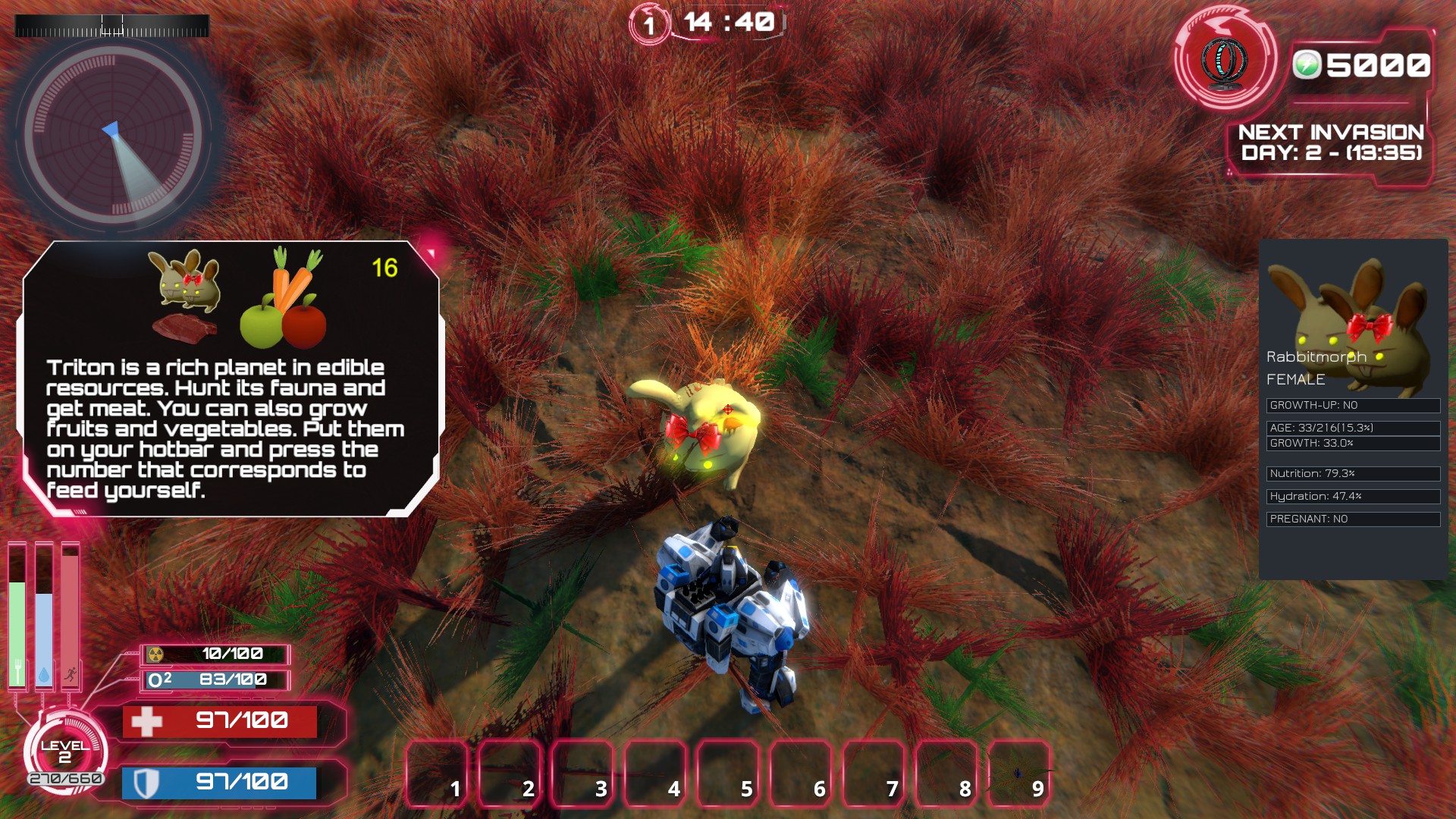
Oxygen and fuel are not found naturally in the Triton environment, so if you want to satisfy these needs you’ll need to craft more components in the particle accelerator. (I’m not sure the developers know what a particle accelerator actually does!) I assume a lack of oxygen will cause the main character to take damage over time, but I’ve not been game to try it. A lack of fuel prevents you from using the protagonist’s jet pack, which means you can’t reach some areas and, probably more importantly, you’ll be confined to the awfully slow ground movement pace that is the norm in the game, since you won’t be able to jump or jet-power your movements.
There’s also a radiation gauge, which increases as you approach or handle Uranium: one of the raw materials, needed for powering and crafting certain objects. Radiation reduction pills can be crafted at the particle accelerator, each of which reduces the gauge by 10 units. So far I’ve not experienced any adverse effects from running around with the gauge pegged at 100, so ultimately it just feels like another unnecessary resource and time sink.
But it looks so pretty!
Indeed, the moon of Triton itself looks very pretty — far more pretty than it could in real life. There’s colourful flora, weird-looking fauna (though only two types of creatures that respond to you, from what I’ve seen so far), reasonable night-time sky and weather and lighting effects, and even an established base (empty) and rank of vehicles (unusable), presumably related to some sort of human habitation. Flora colours are bright and exotic and water is bright yellow, making the Triton landscape look colourful and interesting. The types of flora are different from any other game, too, with huge glowing mushroom-like plants, see-through monotone trees, and a small variety of other more familiar growths. The first few minutes of play reveal a veritable wonderland of interesting and colourful things to see.
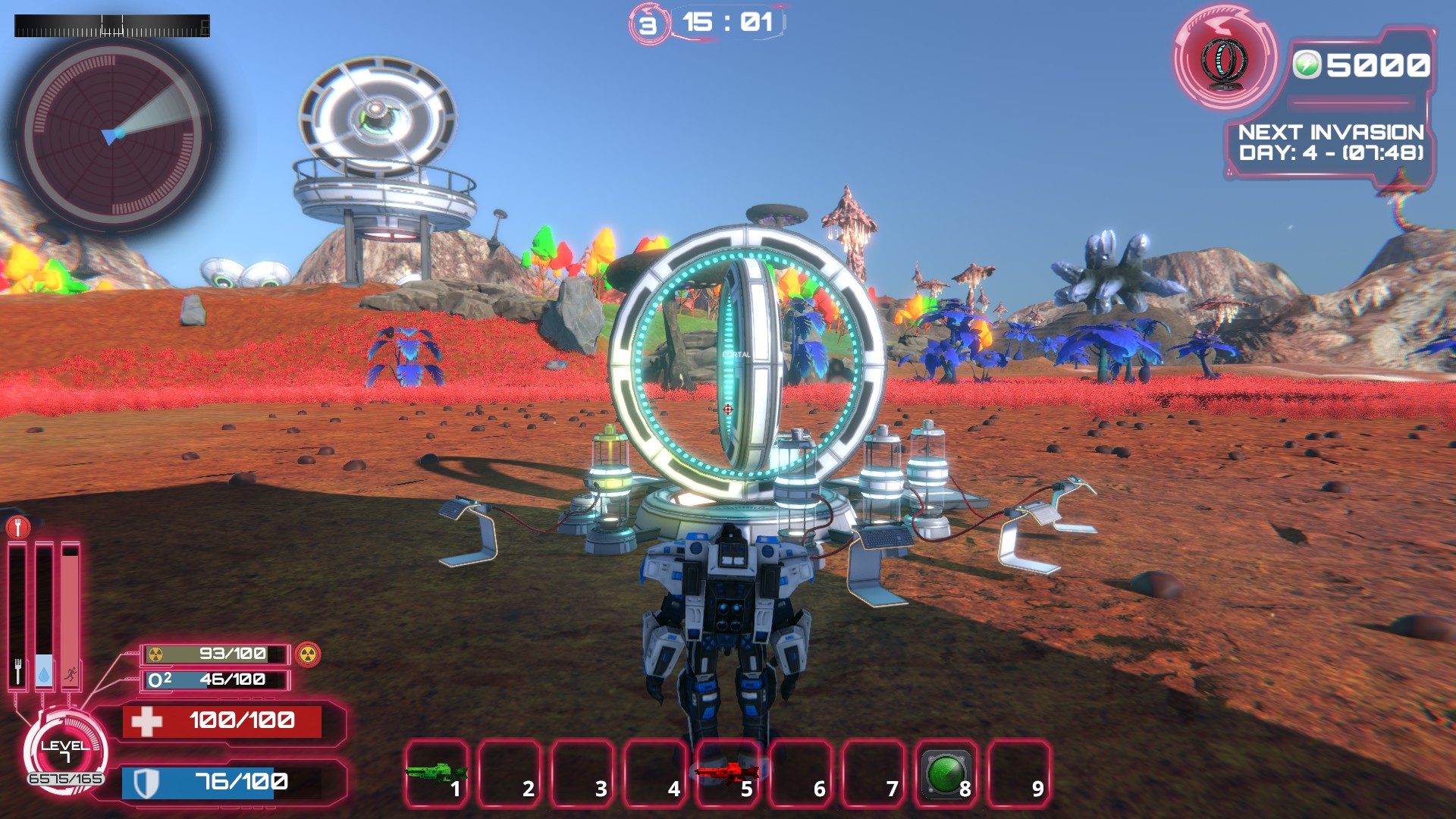
The main character model is weird looking, but sort of appropriate I suppose: it’s like a powered armour space suit, though the size seems a little off to me for some reason; I would have expected to not look quite so diminutive. Animations are okay, but the walk speed is atrocious, making the fuel-gobbling jet-powered jumping the only way to get around with any speed. It also gets stuck in the jumping pose / animation on occasion, and it’s also quite easy to get stuck on terrain (so far a save and reload has always fixed this for me).
Triton’s creatures are weird looking, but interesting. I’ve only seen two types so far, and I’m pretty sure I’ve explored all there is to see of Triton itself. Attack animations are not very satisfying; it’s hard to tell whether you even hit on an attack and enemies just seem to wiggle at you in melee; discerning individual attack animations from them is pretty tricky.
Buildable modules and stations look suitably “spacey”, but the brown wooden walls look completely out of place, especially considering the trees from which the wood is taken are so colourful. Resource nodes, too, look rather silly, like little obelisks of whatever element they contain. That’s not that unusual for the genre, but it does break the immersion a bit. Lighting effects from the time of day and weather are nice, though not spectacular, and the skybox at night looks nice, but on a clear day looks very low-res. I’ve seen a few glitches such as terrain or world objects disappearing and then reappearing after a few steps, or being able to fall through the terrain in places. Oh, and the invisible wall around the playable area is one of the worst I’ve encountered in a modern game; there’s no warning or indication that you’re approaching the edge, the game just prevents you from going any further.
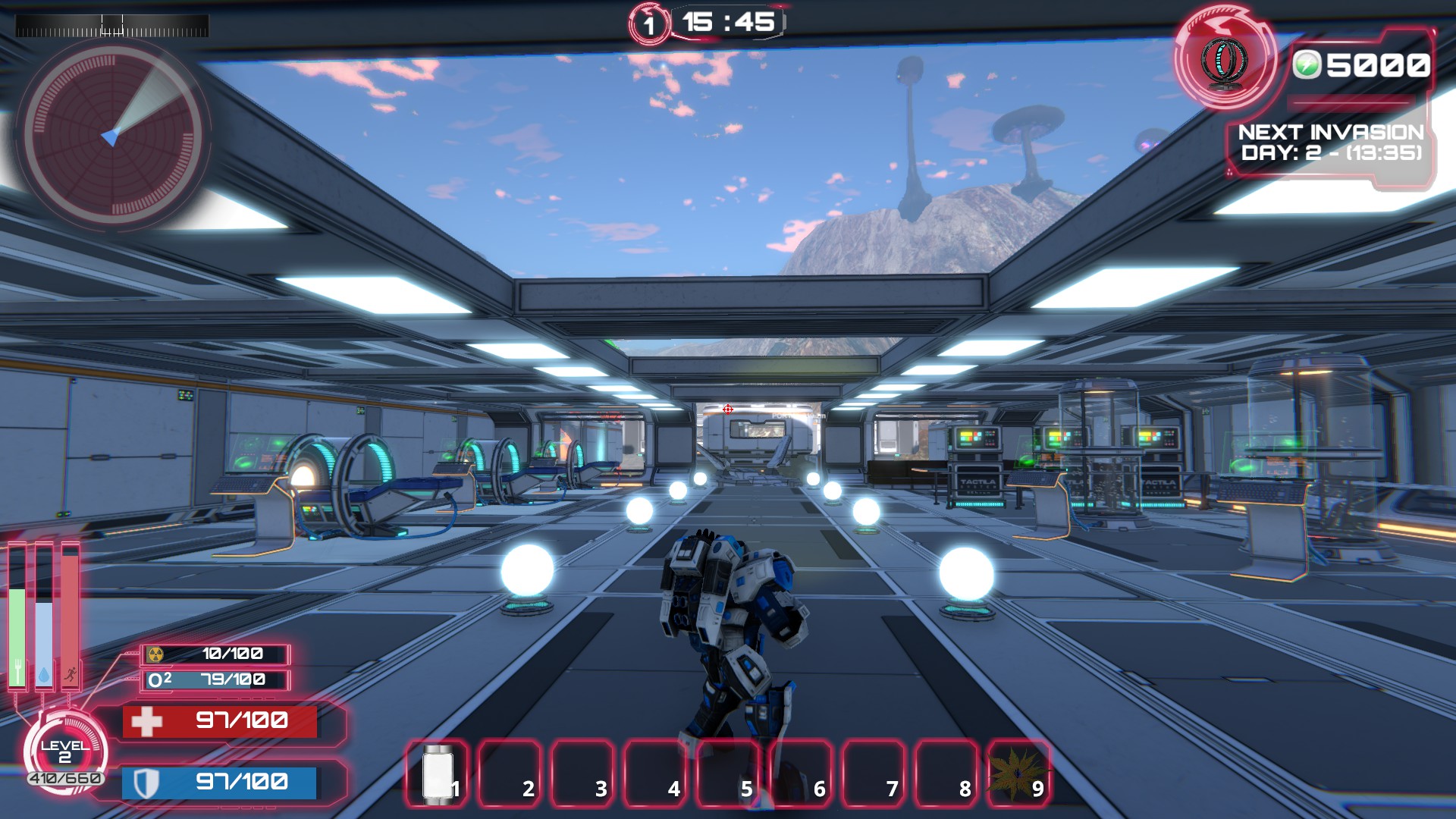
Music is atmospheric: a sort of ambient electronic mix. I don’t know how many tracks there are, but it fits the game very well. Sound effects are basically okay, but could do with some work, too.
The interface is large, ugly, and rather clunky. It basically works, but I hope it’s a placeholder for Early Access and not the final version. Components in inventory and crafting screens appear to be unsorted. There are no tooltips, though clicking on some items will provide information in a separate panel. Text is ugly and colours are pretty garish. The portal map also looks rather hideous and seems rather hard to use; clicking on an object sometimes focuses on it, but not always. Like I say, it basically works, but it ain’t pretty! There are also some grammatical errors.
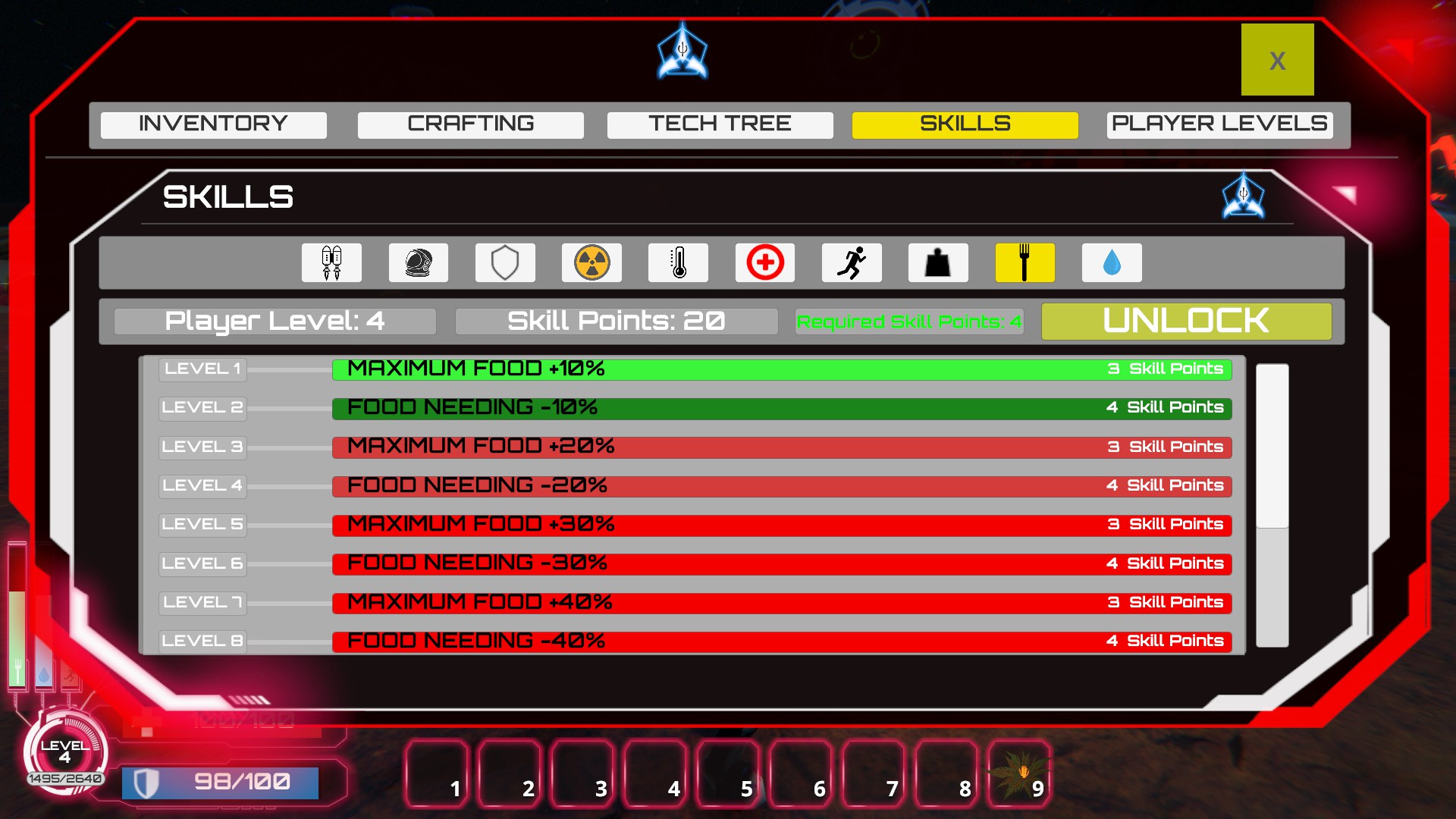
Given the very small world size, performance is pretty terrible on my GTX1070-based laptop. There are long pauses when opening and closing inventory and other screens, and sometimes when crafting a component is completed. I’ve also had pauses at other seemingly random times.
Fun with Portals
I mentioned portals in the introduction and they provide the in-game excuse for enemy waves and also travel to other places around Neptune. I’ve experienced the first a couple of times, but the second is secured away by a grinding wall so fearsome and boring that I just haven’t managed to force myself to get there.
Survival-crafting games with regular, timed, or otherwise predictable base attacks are common. For example, Conan: Exiles has its Purges, 7 Days to Die has the Blood Moon Hordes, and the recent Gaia — another small indie effort — has timed attacks of increasing difficulty, though with a less convincing excuse. Triton Survival doesn’t really offer anything new in this regard, but I must say I thought the sheer magnitude of the attacks was impressive, even for the first attack.
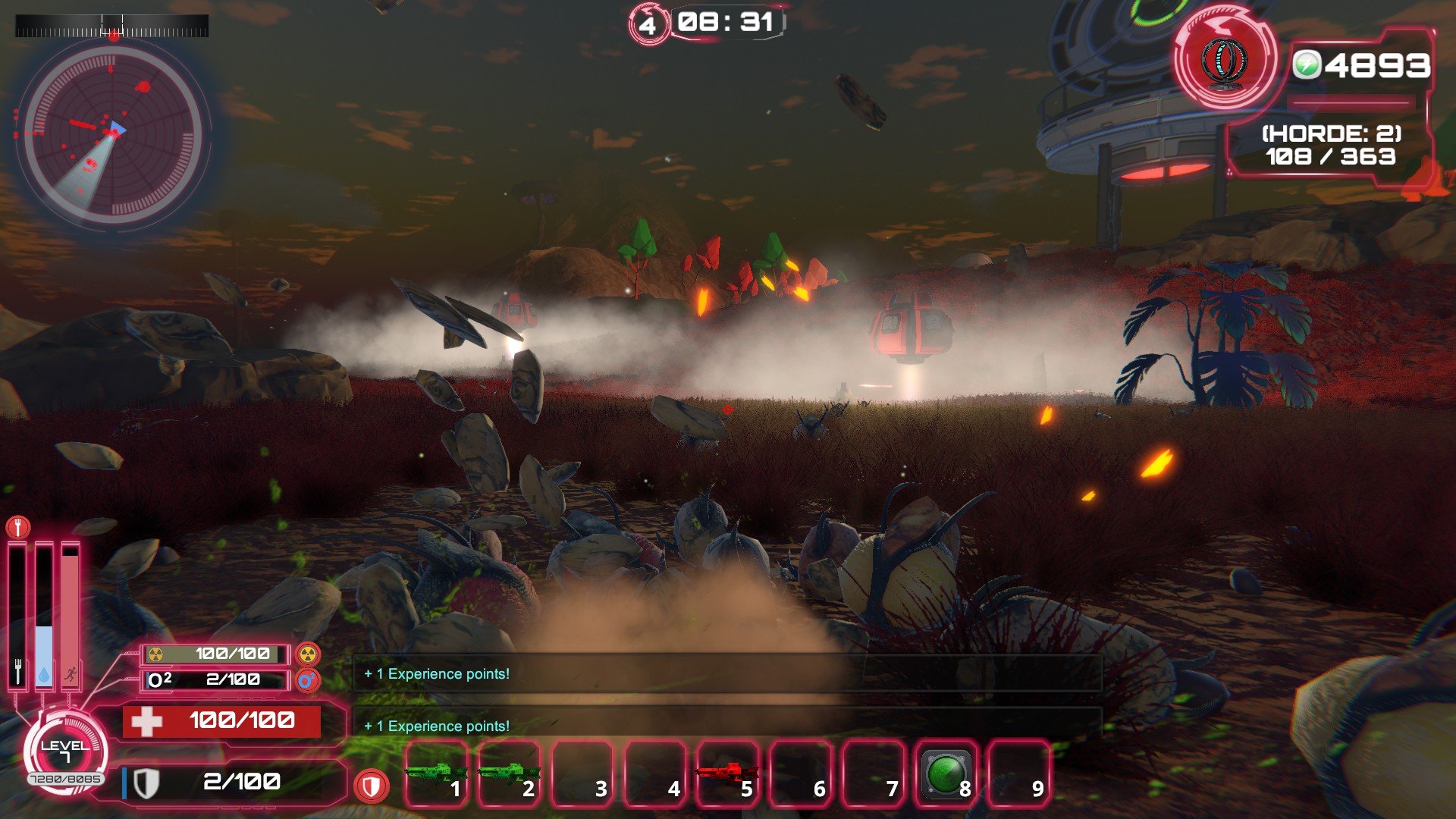
These swarm attacks are short-lived encounters, but they’re fast and frantic as you try to protect your portal from the many, many intruders intent on destroying it. AI seems to be very basic, with creatures seeming to pick a target somewhat at random from the portal, any gun turrets you have built, and the main character, but the sheer number of attackers has some appeal.
Unfortunately there only seems to be a single weapon type available so far, which includes unlimited ammunition during the first swarm, but after that you’ll need to grind endlessly to make enough bullets for subsequent swarms, as well as some short-range mortar-like missiles, which are very limited in number. There’s also only a single defensive turret type available, and I couldn’t get it working. My first turret spun around and pointed straight at the ground, refusing to shoot at all while it was quickly overrun and destroyed. I kept my second turret in my inventory after the first swarm and when I went back to try to place it in preparation for the second swarm, it was no longer there: replaced by a second hand-held blaster gun. And there appear to be only a very small number of enemy types, too; so far I’ve only seen a number of slug-like melee attackers and some weird giant beetle things with guns mounted on their backs. Still, even with health and armour bars that are meaningless — you can keep running around happily when they’re both empty — I found these the most fun parts of the game as it exists so far.
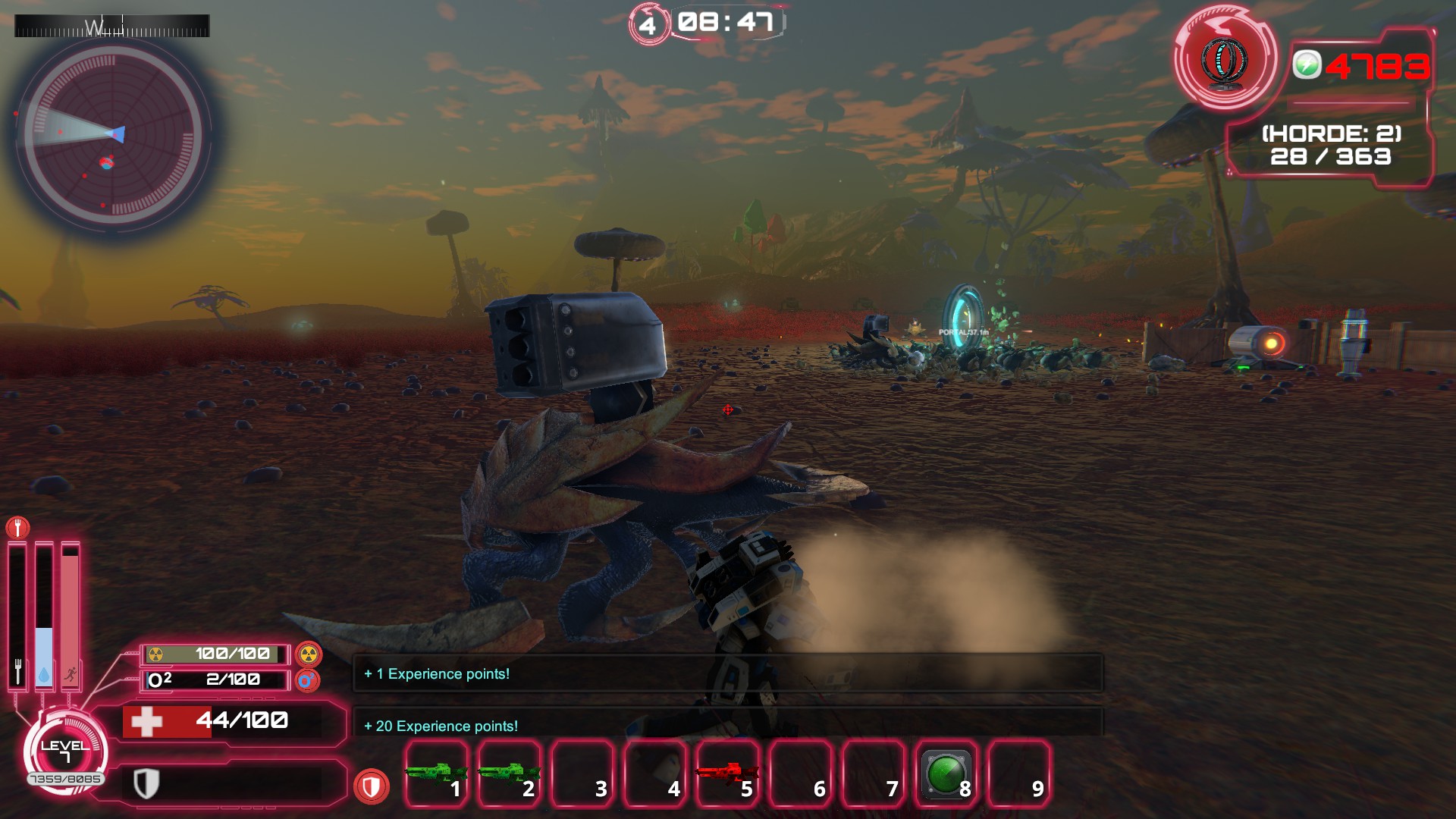
The second plot hook connected to the portal is the ability to travel through it to Neptune’s other moons or the planet itself. This sounds pretty cool and may go some way towards making up for the tiny play area available on Triton, but after spending a couple of hours solely on trying to mine the Uranium required to build portal batteries and then provide enough power to actually travel anywhere, and then having the save-load cycle reset the portal power back to 5000 after I had to go and deal with some real-world responsibilities, I’ve given up on this goal, too.
You see, you can use the portal at any time to access a 3D map of Neptune and its moons, and select one of these to travel to. The interface tells you how many units of power the portal needs and, presumably, lets you travel there if you have enough. But the smallest amount required to travel anywhere appears to be just over 6500 units. That means portal batteries need to be connected and powered and transfer over 1500 units from the base level. That’s 1500 swings of your fist — or somewhere between 750 and 1500 zaps of a carbon-eating short-ranged resource-collecting gun — against Uranium nodes that provide at most 20 units of Uranium each before you need to wait for them to respawn. And if you care about the survival aspects, which don’t currently seem to matter, that’s also food, water, oxygen, fuel, and radiation-reducing pills enough to last you for the time it takes to mine the Uranium.
Given how little there is to actually do at the moment, this seemed a worthwhile goal. But, much like all of the other crafting and building in the game, it simply takes too long for me to bother, especially since I’d have to do it all in a single sitting.
Verdict
Triton Survival feels like it’s on the right track to becoming an interesting survival-crafting game that’s worthwhile playing, but it has a long way to go. At the moment it seems to be full of grind simply for the sake of grind, and that’s no fun; survival-crafting grind has to be suitably rewarding in order to feel like a worthwhile task, and in Triton Survival it’s simply not.
I expect most of the bugs will be addressed through Early Access, so I’m not even going to bother mentioning them individually, and I’d hope the interface will be massively reworked, since it’s clunky enough to be annoying and ugly enough to detract from the game as it is. But the big problems at the moment are lack of content, tiny world size, and that unrelenting and unrewarding grind.
Definitely keep an eye on Triton Survival if you’re a fan of the genre and you’ve played the more established titles, but I wouldn’t recommend actually purchasing the game until there’s a lot more to do and the gameplay has been significantly rebalanced.
Editor’s Note
We asked the developers if they had any comments and they were very positive about fixing the issues mentioned in this review, and other sources. They say:
“This is first version of an Early Access game and that we will continue to improve and expand the game throughout this stage of development, listening to the aspects that the community considers a priority.”

